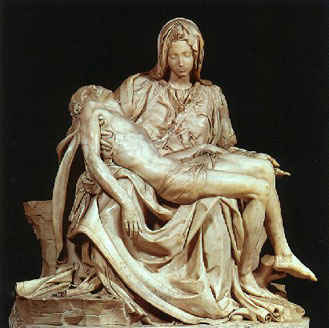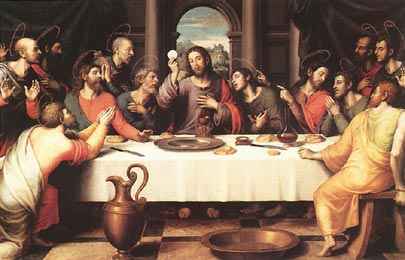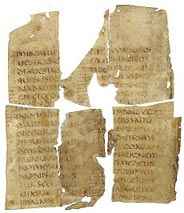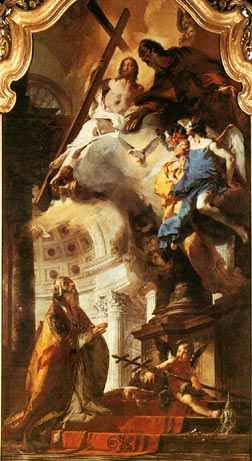|
Distortions of the Roman Catholic Church Just as the works of the Old Testament would not have survived without being copied and recopied, so too did the survival of the New Testament depend on the work of generation after generation of scribal copyists. But its survival also depended on the practice of making and distributing duplicate manuscripts, because, despite the reverence of early Christians for the written Gospel, decay was not the only threat to its survival. War, accident, persecution, factionalism, and the suppression of heresies all played their role in obliterating the original texts (or autographs) as well as the early copies which were made from them.
Just as the works of the Old Testament would not have survived without being copied and recopied, so too did the survival of the New Testament depend on the work of generation after generation of scribal copyists. But its survival also depended on the practice of making and distributing duplicate manuscripts, because, despite the reverence of early Christians for the written Gospel, decay was not the only threat to its survival. War, accident, persecution, factionalism, and the suppression of heresies all played their role in obliterating the original texts (or autographs) as well as the early copies which were made from them.
Consequently, virtually nothing remains from the early Christian period. The original texts of the New Testament simply no longer exist. The Gospels of Luke, Matthew, Mark, and John only exist as decaying copies of copies—which themselves may have been heavily edited or marred with accidental errors. What's more, even these early copies are fragmented and few. It should be noted that only 35 of these copies date back to before 400 A.D., and amazingly only 80 manuscript copies date before 800 A.D. The two earliest fragments of John's gospel, for example, are copies transcribed in 200 A.D.—at least 100 years after the death of the Apostle himself. Not surprisingly, this fact has caused many to speculate whether the manuscript really represents the words of John at all. Meanwhile, mainstream historians, linguists, and religious scholars agree that the Gospel of John, as we know it, differs markedly from the Gospel of John that was available to the early Christian Church.
Interestingly enough, this entire story (or periscope) is missing from the earliest version of John. It is also missing from early Latin translations of the text, missing from older versions used in the Holy Land and in fact, according to the 12th century Byzantine scholar Euthymius Zigabenus (the earliest church father to comment on the passage), accurate copies of the Gospel of John do not and should not contain it. Furthermore, if one blocks out the entire little story, John 7:52 flows just fine into John 8:12, lending further credence to the idea that the passage was simply inserted after the fact. Who inserted it, and why, remains a mystery. In yet another example, in all versions of John (9:35) transcribed after the 5th century one can read the following passage: "Jesus heard that they had cast him out; and when he had found him, he said unto him, Dost thou believe on the Son of God?" [emphasis added]. But if one compares this version to papyri and codices transcribed before the 5th century, one finds this rendering: "Jesus heard that they had cast him out, and having found him he said, Do you believe in the Son of man?" [emphasis added]. Again, the point of these examples is to illustrate the fact that someone, at some point, made significant changes to the Gospel of John. Perhaps in some cases it was an unintended error (it was quite common for scribes to lose their place while copying manuscripts and "paste" a paragraph in where it didnt belong), or perhaps it was someone's attempt to restore to the record a piece of wisdom that had been lost with the suppression of some other Gospel manuscript. We don't know. But that the phrase "Son of man" could have been replaced by "Son of God" by accident—and would then be perpetuated unchallenged—seems ludicrous, given the significance of the wording. What we do know is that this kind of discrepancy or tampering is not unique to the Gospel of John. As mentioned earlier, we cannot know what the original texts said with any certainty. The original manuscripts are apparently gone. But as we compare the early copies, and compare them also with later versions handed down through other branches of the Church (such as Eastern Orthodox, Coptic Christian, etc.), we do notice all kinds of variations and discrepancies.
The natural question is: how did these discrepancies occur? Naturally some of it must be, as mentioned earlier, scribal error, simple miscopying. But the fact that the bulk of it occurs where it matters most—where it would have most impacted the politics and policies of the Church—is terribly suspicious. Are we supposed to believe this is all mere coincidence? Considering that the Roman Catholic Church (under whose watch most of these discrepancies crept in) is about as forthcoming with such information as the Cold War Kremlin, it may be some time before we get the straight scoop on how and why these alterations occurred and what in fact it means for the validity of Church dogma. In the meantime, it is commonly acknowledged fact that the Gospels of Matthew, Mark, Luke, and John (i.e. the four Gospels accepted as authentic by the Church) bear all the signs of secondary texts. That is, each one appears to have been pieced together from other, earlier, works, perhaps both written and oral.
And while it is often generously granted that these texts may have been put together from materials written or dictated directly by the Apostles, there is in fact no real proof of this. Additionally, the Church's claims that Hebrews was written by Paul and Revelations by John—claims made to beef up the authority of the dead Apostles and their successors in authority, the popes and bishops—are not warranted by the evidence. In fact, historians acknowledge that it is not known who wrote these texts.
Finally, it is important to note that while the Church began its reign with Greek versions of the New Testament texts and Greek translations of the Old Testament/Hebrew Bible (i.e. the Septuagint), the growing domination of the Roman Church (vis-a-vis other branches of the early Church) meant that these works would inevitably be translated into Latin. Qualities of translation varied from version to version, culminating in the work of Saint Jerome (342-420) who produced the earliest definitive Latin translation, known as The Vulgate. Although Jerome allegedly sought to excise errors in the Old Testament translations by referring back to Hebrew texts, modern scholars point out that he could not have done this with much thoroughness (or was simply ignorant of Hebrew/Jewish idioms) for serious errors of translation (and therefore meaning) remained in the Vulgate. Thus both Old and New Testament materials passed down by the Catholic Church were suspect, riddled with errors and perhaps outright forgeries. None of this stemmed the growing power of the Church in the least. Naturally, the larger an organization grows, the larger the potential for conflict and the greater the fireworks when dissent brews amongst those at the top. In the earliest days of the Church, while the Apostle John still lived, Bishop Clement (head of the Church at Rome) solved this problem by convincing the faithful that stability of the Church and the continuance of the new religion could be had by following a military like organization—i.e. through absolute obedience to leaders who themselves were absolutely obedient to the man at the top. Oddly enough, Clement finessed himself into the role of man at the top, though the last Apostle was still alive.
By 1054, the primacy of the Roman branch of the Church had grown to such proportions that chief Bishop, now called Pope, moved to assert his absolute power over all the entire Christian Church. Thus emerged the Roman Catholic Church and—as the Constantinople arm of the Church rebelled against this usurpation— the Eastern Orthodox Church. Eventually, each would develop its own official Bible, rituals, and rules, although having been essentially a joint entity for 1,000 years, much remained common. The legacy of the Roman Catholic Church has been a powerful one. For centuries, its voice and perspective was the dominant authority on the life and teachings of Jesus, on its proper interpretation, and on the allowable forms of Christian practice and moral life. It is only in recent times that secular and religious scholars have gathered together the alternative Christian voices represented in other early branchings of the Christian Church (such as the Coptic Christian Church, the Syrian Church, etc.) and compared these with various finds being made in libraries and archaeological digs around the mediterranean region and made these available to the general public for reading and study. Together, these alternative "voices" offer a new way of understanding the teachings of Jesus, even as they introduce further questions and enigmas. At the same time, these same alternative source materials have made it blatantly clear that although the Roman Catholic Church continues to style itself as the divinely-appointed guardian of the Gospel and as the successor of Jesus' ministry, it has in fact for centuries played the role of censor and false prophet, repressing and misconstruing knowledge that had already been suppressed, and thus distorted, by the earliest leaders of the Christian Church. What was once hidden from the spiritually unadvanced for mystical (and perhaps political) reasons was later simply obliterated by Catholicism. Meanwhile, those portions of the teachings that had been public were further distorted and deleted, supplanted by the growing body of Catholic doctrine.
|
 Take, for example, the popular story (John 7:53-8:11) in which Jesus saves a woman from being stoned as an adulteress. It is from this passage that Christianity draws the oft-paraphrased advice, "Let him who is without sin among you be the first to throw a stone at her."
Take, for example, the popular story (John 7:53-8:11) in which Jesus saves a woman from being stoned as an adulteress. It is from this passage that Christianity draws the oft-paraphrased advice, "Let him who is without sin among you be the first to throw a stone at her."
 In total there are 300,000 discrepancies in the New Testament amongst various early manuscript versions. Significantly, the greatest amount of variation (and revision) is found in the most significant portions of the New Testament manuscripts—that is, within those parts that most determine official Church doctrine: the birth and death of Christ, the usage of the Eucharist, his time in the garden of Gethsemane, his utterings on the cross, his resurrection, and his ascension to heaven.
In total there are 300,000 discrepancies in the New Testament amongst various early manuscript versions. Significantly, the greatest amount of variation (and revision) is found in the most significant portions of the New Testament manuscripts—that is, within those parts that most determine official Church doctrine: the birth and death of Christ, the usage of the Eucharist, his time in the garden of Gethsemane, his utterings on the cross, his resurrection, and his ascension to heaven.

 Clement's dominant role was inherited and built upon by his successors. Eventually, other branches of the Church withered away, leaving Rome and Antioch (later Constantinople) as twin beacons of the faith. Rome continued to wield a disproportionate influence—a fact which the Catholic Church explains mythologically by invoking the Apostles Peter and Paul, whom it claims fostered the early Roman Church before their martyrdoms. Whatever the reason for the Roman branches' early importance (some think it may have been foretold by Jesus and thus become a self-fulfilling prophecy), it could only grow in power once it was turned into the official state religion of the Roman Empire.
Clement's dominant role was inherited and built upon by his successors. Eventually, other branches of the Church withered away, leaving Rome and Antioch (later Constantinople) as twin beacons of the faith. Rome continued to wield a disproportionate influence—a fact which the Catholic Church explains mythologically by invoking the Apostles Peter and Paul, whom it claims fostered the early Roman Church before their martyrdoms. Whatever the reason for the Roman branches' early importance (some think it may have been foretold by Jesus and thus become a self-fulfilling prophecy), it could only grow in power once it was turned into the official state religion of the Roman Empire.